sTRANGEmUSIC (NYC) with
SERIOUS MUSIC (LA) present
ONE-TWO-THREE
Concerts
NYC's very own permanent floating
new music series
Concert
#14
Monday, April 29, 2002 at 7:30 PM
THE
CUTTING ROOM
19 W. 24th Street (6th Ave. & B'way)
===================================================================================
from
TIME OUT NEW YORK
Issue No. 343, April 25-May
2:
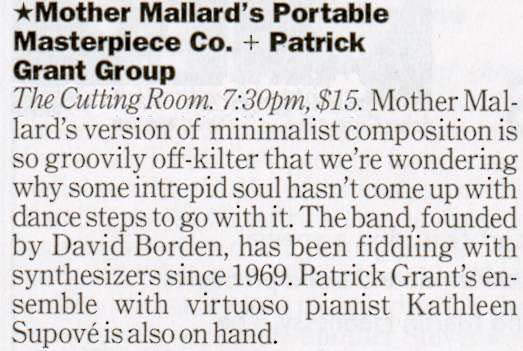
=================================================================================
A Note from Patrick Grant:
Anybody
who is interested in any way at all in the electronic music of
today owes
a debt to pioneers David Borden and Mother Mallard for their
groundbreaking
contributions; whether it be in the realm of composition,
realtime performance,
or in the feedback given to the designers in the
development of the MiniMoog,
theirs is a lasting legacy which continues
to add to the repertoire of live
electronic music.
David Borden, also
known for his "The Continuing Story of Counterpoint
Parts 1 through
12" and his contribution to the soundtrack of "The
Exorcist",
will be giving the NYC premieres of some new works on this
concert, bringing
Mother Mallard into the 21st century.
If
you are in the area please try to attend this event and be a part of
new
music's past, present, & future.
PG - NYC
=================================================================================
MOTHER
MALLARD'S
PORTABLE MASTERPIECE CO.
David
Borden
keyboard
Blaise
Bryski
keyboard
David
Yearsley
keyboard
w/
special guest:
Daniel
Goode
clarinet
=================================================================================
1. The Continuing Story of Counterpoint Part 7 (1978)
2. The Continuing Story of Counterpoint Part 8A (1979)
3. Christ! Mozart Land (2002)
4. The Continuing Story of Counterpoint Part 5 (1977)
5. The Continuing Story of Counterpoint Part 8 (1979)
6. Naked American (2002)
7. The Continuing Story of Counterpoint Part 9 (1980)
=================================================================================
Notes:
The Continuing Story of Counterpoint (hereafter referred to as TCSOC) which was begun in 1976 and completed in 1987, derives its title from several sources. At Phil Glass' Town Hall concert of 1974 he and his ensemble premiered a couple of pieces from a new cycle he called "Another Look at Harmony". These pieces later became assimilated into "Einstein on the Beach," but the original title struck a chord with me. My approach had always been contrapuntal, so I filed away in my mind the idea of using the word "counterpoint" in the title of a future series of pieces. When I actually started composing the first of these pieces (1976) the soap opera parody "Mary Hartman, Mary Hartman" was becoming a huge success on television. This gave me the idea for a title that sounded like a soap opera. And lastly, although it was purely subconscious, I think I must have had "The Continuing Story of Bungalow Bill," the title of a tune from the Beatles' White Album floating around in my psyche somewhere. It fit the bill perfectly. It didn't sound didactic, it alluded to history, and it contained a few multi-syllabic words instead of those awful one-word titles of esoteric foreign origin used by so many academic composers.
TCSOC
began with one simple note-against-note idea and the desire to develop my own
contrapuntal language.
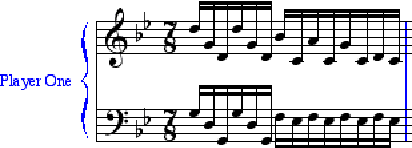
My approach was influenced primarily, but not completely, by contrapuntal composers from Machaut (14th century) to Josquin (15th -16th century). This was the period before functional harmony was codified; I have always been drawn to this period because of my inability to "hear" functional harmony. As long as I can remember, I have had perfect pitch and always listened to music as simultaneous melodies and rhythms, so that's how I approach my work. Even though my "harmonic hearing" ability has improved with age, I still don't hear functions, but absolute pitches.
Another catalyst in developing my own contrapuntal language was the disappointment I felt after several years of taking all available courses in counterpoint at both Eastman and Harvard. Before Eastman, I also studied aspects of counterpoint with Hugo Norden at Boston University and with jazz composer/performer Jimmy Giuffre. But even after diligently studying Fux's Gradus ad Parnassum (1725) on my own, I came away unfulfilled. This is the book that Haydn, Mozart and Beethoven treated as a bible. It is a complete step by step guide to modal counterpoint; Haydn never left home without it. It was supposed to lead to the promised land of intellectual control and spiritual soaring that mastery of the art of counterpoint brings with it. It brought me back to the realization that artistic theories may bring creative artists to the edge of the water, but jumping in is another matter.
So, I started these pieces with the intention of controlling large structures by composing not only simultaneous melodies that each had their own personality, but in some cases, simultaneous two-handed keyboard parts that could stand alone as solo parts but when combined with the others, lost their individuality to the whole. This idea came from Buckminster Fuller's definition of synergy: behavior of whole systems he parts of TCSOC, I composed one person's part all the way through before adding another part. The pieces are held together by disparate meters (rhythmic elements) that resolve themselves in cycles and by the "harmonic" content of modal scales. The twelve parts are cyclical and refer to themselves in various ways, and all parts contain the basic note-against-note melodic figure (shown above) in varying degrees.
Originally these pieces were composed for an ensemble of three keyboard performers playing an RMI Electric Piano (polyphonic) and five Moog Synthesizers ( three modular systems and two MiniMoogs). The Moogs were all monophonic, so a performer would play two keyboards, one for each hand, much like an organist. Sometimes a performer would play the RMI Piano with the right hand, and a MiniMoog with the left. This was true of TCSOC Part Five. With so many keyboards available, there were several configurations. Eventually another polyphonic keyboard was added ( a Fender Rhodes Piano) which keyboardist Chip Smith brought with him when he replaced Steve Drews in 1977. In the 1980s the ensemble went through major changes with digital instruments replacing the original Moogs, and the personnel expanded to include an electric guitar, soprano and a wind player (Les Thimmig) who played all the wind instruments. With these changes TCSOC also expanded its scope. It was composed slowly over a period of eleven years.
The Parts of TCSOC being performed this evening were completed between 1977 and 1980. They were all designed to be performed by three keyboard performers. The timbral quality of the pieces has changed over time, which they were designed to do. Even as they were being
unpredicted by the behavior of any of its parts taken separately. I liked this definition of synergy so much that in most of tcomposed I realized that electronic instruments would continue to evolve and that the sounds would not be the same, although I didn't realize that computers would eventually replace the analog instruments we had at the time. The keyboards we are performing on tonight, with the exception of the MiniMoog are all dedicated computers.
TCSOC's twelve parts were composed as three sets of four each. The middle group (5-8) contains some of the most densely textured pieces of the entire collection. The density of sound has something to do with the fact that the texture of Parts 5, 7 & 8 are the same: two full polyphonic keyboard parts plus a two-voice part. Also, this middle group of counterpoint pieces is more structurally integrated than the other two groups. Entire players' parts are lifted from Part 5 and used in Parts 7 & 8 (Player One's part is basically the same in Parts 5 and 7 and Player Two's part is basically the same in Parts 5 and 8). It also means that Player One and Two don't have to learn another piece to play Parts 7 and 8. The compositional challenge was to make Parts 7 and 8 sound musically different than Part 5 even though 1/3 of the notes were exactly the same. This was a self-conscious test of the synergy problem.
In addition, it was found that there can be three partial versions of Part 8 in addition to the complete one we're performing tonight (Player One & Two, Player Two and Three, Player One and Three), 8A, 8B and 8C. This is not true of the Parts of TCSOC and I'm not sure why.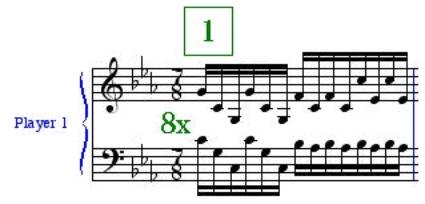
Part Nine is strongly related to Part One. Part Nine opens with a variation of the main motive performed by Player 1.
This short idea is the main building block of Part Nine, and appears in several guises throughout. In general feeling and style, this piece belongs with Parts One and Three. Without using the usual imitative techniques of counterpoint, Part Nine and the other parts mentioned above attempt to establish a part for each player that stands on its own, and when combined add up synergistically; as mentioned above, produces a whole that is unpredicted by the parts taken separately. This is almost the opposite of traditional counterpoint in which the separate parts of canons necessarily predict the whole or at least much of it. These three particular pieces are studies in two kinds of contrapuntal movement. Part Nine has a slightly lighter texture than its sister parts (1 & 3) because there are three simultaneous fast note-against-note lines against three slower moving ones. In the earlier pieces, there are four simultaneous fast lines contrasted by two slower ones.
Another difference between Part Nine and Parts One and Three is that in Nine the key signature changes more often and the relationship between the different parts is more polymetric. As a performer, it's very easy to get lost, so concentration must be constant and intense. This is especially true of the ending. It is based on a repetition of this variation of the main motive: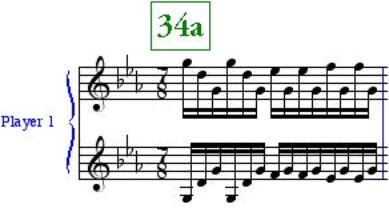
followed quickly by a series of expanding ending figures beginning with:
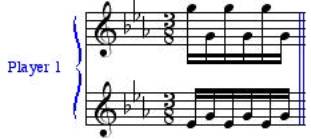
There are thirteen endings altogether, each one a beat longer than the previous one. The longer held notes are configured somewhat differently, so that some of the players are counting differently than others. It requires the utmost concentration to end together correctly.
The Anagram Portraits* (pieces whose titles are anagrams of the subject's name) are pieces composed to honor friends, teachers and others who have made a distinct impression on me. Among them are "Her Inner Lock" for composer (and one of my teachers) Leon Kirchner, "Unjust Malaise" in memory of Julius Eastman (a friend of many years) and "I Trill Tunes" for Nurit Tilles (a friend and one-time member of my Mother Mallard ensemble). Recently I completed "Christ! Mozart Land" for clarinetist Richard Stoltzman. I chose to use the clarinet part from the first movement ("Allegro") of Mozart's Clarinet Quintet in A, K 581 as a kind of "cantus firmus". Around this, I composed new music for synthesizers (designed to be played live by three keyboard performers) as an accompaniment to the original clarinet part. I think of it as moving Mozart into a new apartment.
All of the Anagram Portraits* that I have chosen to do have a numinous synchronicity about them. When I started "Her Inner Lock" for Leon Kirchner, my locksmith brother, unknown to me, was hired to replace all of the locks in Kirchner's house in Cambridge, Mass. When Julius Eastman died from the combined effects of substance abuse and AIDS, I wanted to compose an elegy for him but it wasn't until I did his anagram that I came across the perfect description of his demise: "Unjust Malaise." Tonight we are premiering "Naked American" composed for my writer friend Diane Ackerman. Even though I had been planning to do this piece for a couple of years, when I actually started working on it, she was called to pose nude for a calendar, which she did. Next on my list is "Severe Itch" for Steve Reich which I am reluctant to start fearing that he may acquire some horrible rash.
When I begin to compose an Anagram Portrait, I allow the images generated by the anagram itself work on my subconscious rather than try to make a portrait of the person as I know them although that plays a part too. I have to let the anagram percolate for awhile, sometimes a long while, before I begin the piece. The first naked American I ever saw, was myself in a mirror in childhood. Probably the most prominent naked American I've ever seen was at Harvard when I started graduate school. I joined the noontime swimming club and found that no one wore bathing suits in this all-male venue. I walked into the pool on my first day, and there in front of me, talking with another naked American was John Kenneth Galbraith who was then President Kennedy's economic advisor. This piece draws on an image I have from my past when I spent a summer playing in a Boston strip club in a section of the city that would later be called "the Combat Zone" due to the many street fights that took place there. There was a very beautiful woman, known only as "Ondine" who was a fantastic singer, and also the most artistic of all the strippers. It was a place whose atmosphere was tough and depressing. All of the women were forced to be bar girls as well. As soon as I made enough money to take with me back to college, I quit. Before I left, Ondine grabbed me and kissed me.
* some have been recorded on the CD "Places, Times & People" available on the Cuneiform label from amazon.com. TCSOC is available in its entirety.
==================================================
Bios - Mother Mallard's Portable Masterpiece Co. 2002
David Borden founded Mother Mallard's Portable Masterpiece Co. in 1969 with the generous support of Robert Moog. The group became the world's first synthesizer ensemble. "Mother Mallard turns out some of the best synthesizer music around." - New York Times. His 'The Continuing Story of Counterpoint,' a twelve-part cycle of pieces for synthesizers, acoustic instruments and voice has been called the 'Goldberg Variations of minimalism.' Borden's music is available on the Cuneiform, CRI, Lameduck and Arbiter labels. He is currently the Director of the Digital Music Program at Cornell University.
Blaise
Bryski is a graduate of the University of Cincinnati College-Conservatory
of Music and received his Master of Fine Arts degree from the California Institute
of the Arts. He was a member for three years of the master class of Aube Tzerko.
Mr. Bryski performed for many years as an accompanist for the UCLA Department
of Music and was a professional pianist in Los Angeles in many styles including
rock and jazz.
David Yearsley was educated at Harvard and Stanford, where he received his Ph.D. in music history. Since winning first prize at the 1994 Bruges Early Music Festival, Mr. Yearsley has enjoyed an active recital career throughout the United States and Europe as an organist, harpsichordist, and clavichordist. His scholarly work has appeared in the Journal of the American Musicological Society, Music & Letters, Early Music and the Journal of Seventeenth-Century Music; his book, Bach and the Meanings of Counterpoint is forthcoming from Cambridge University Press. His recording of the music of Delphin and Nicolaus Adam Strungk, played on the historic Arp Schnitger organ in Norden, Germany, was recently issued on Loft (www.loftrecordings.com); The Great Contest: Bach, Scarlatti, Handel is just out from the same label this fall. Music critic for the Anderson Valley Advertiser, America's foremost country weekly, Mr. Yearsley is an assistant professor of music at Cornell University.
=================================================================================
sTRANGE
qUOTE:
"I'm dancing barefoot
Heading for a spin
Some sTRANGEmUSIC drives me on
Makes me come up like some heroine
Oh God
I feel for you..."
--- Irish rock group U2